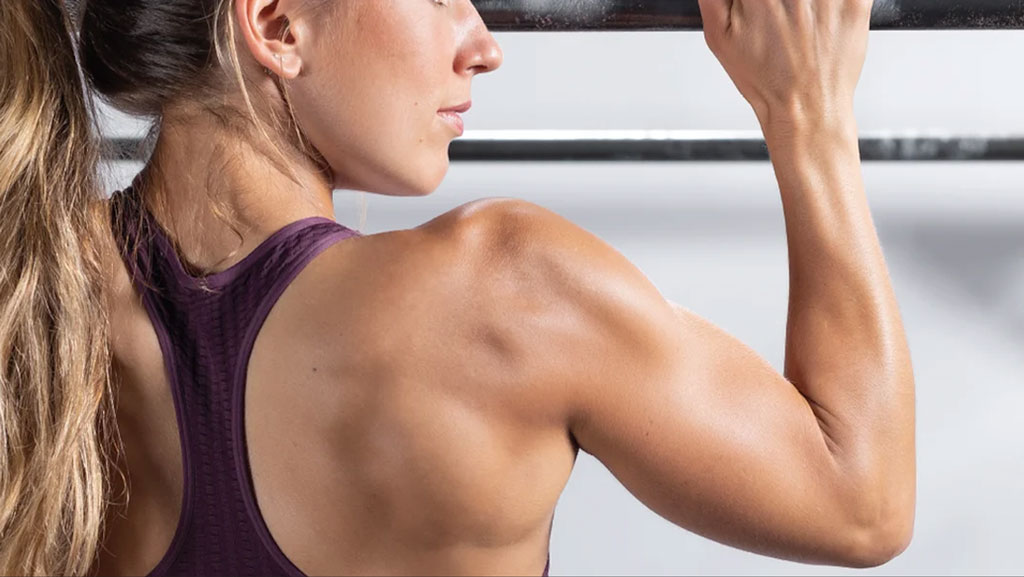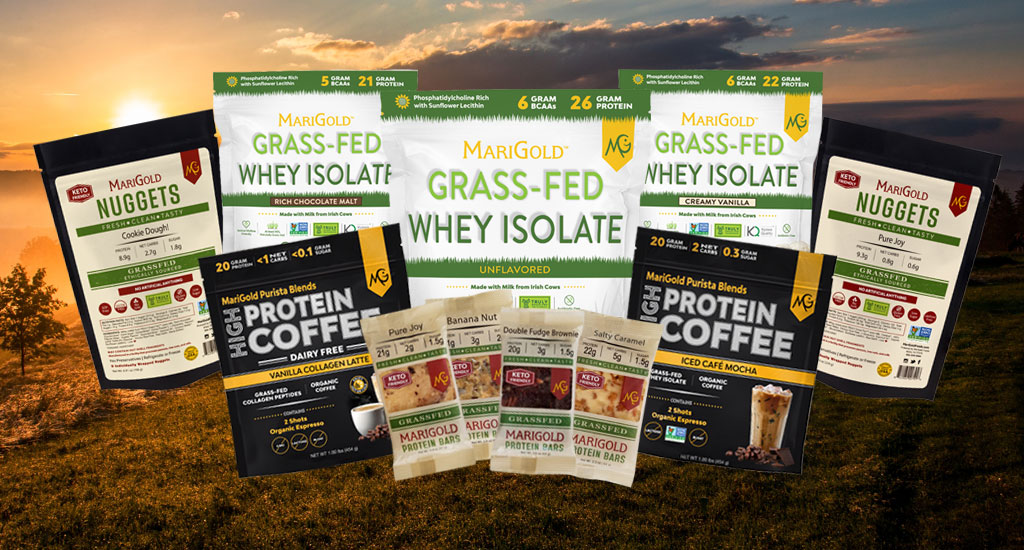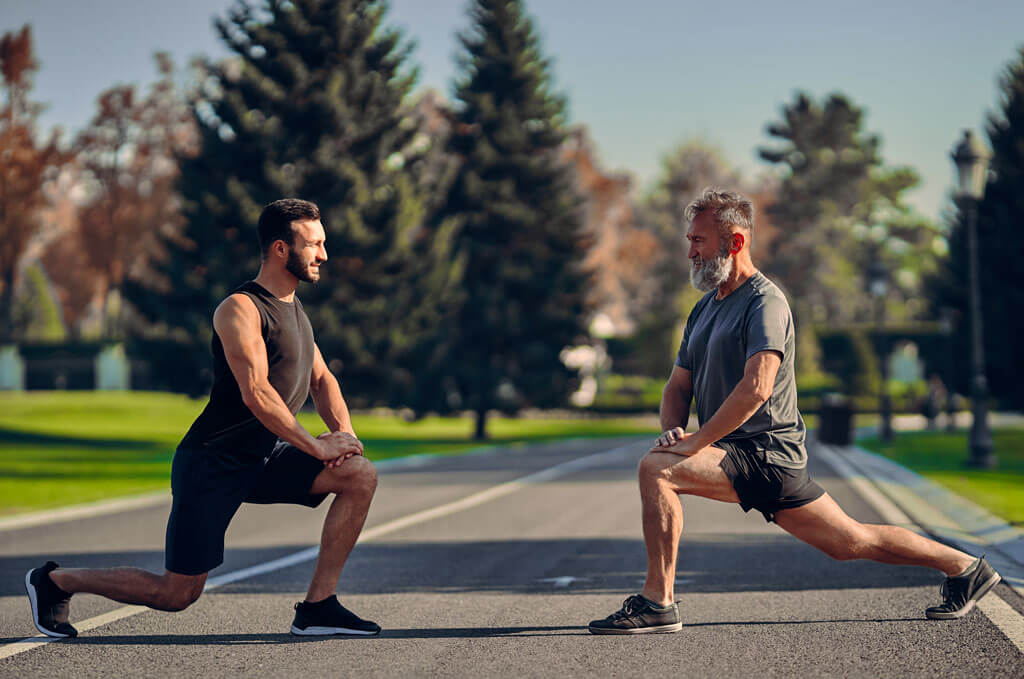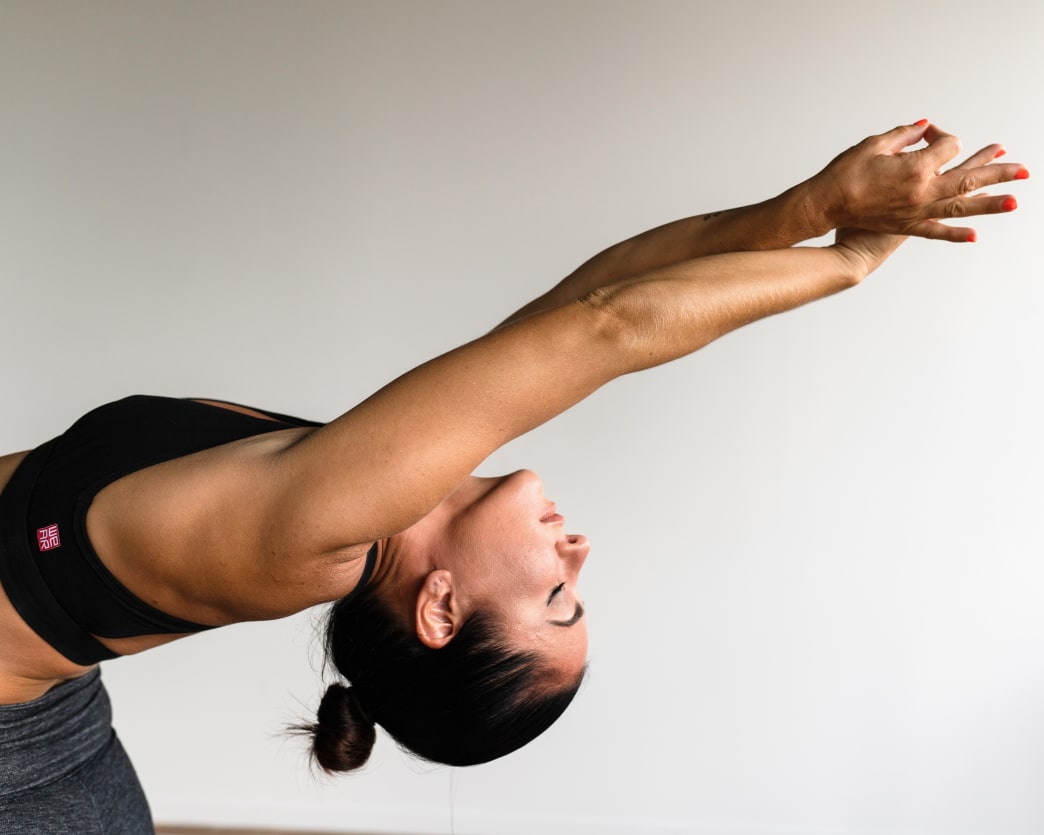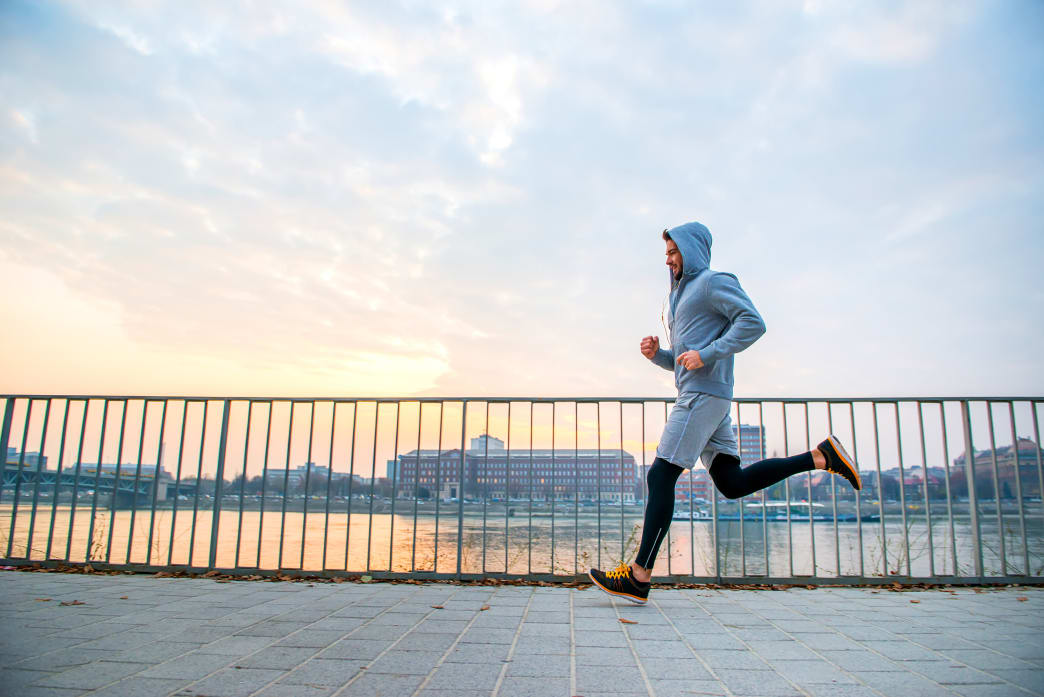Return to your ancestral roots with these six innate movement patterns to improve your functional — and physique — results.
The term “functional training” has gotten a bad rap, probably because of an inordinate number of so-called influencers who perform every strength move while standing on one leg wrapped from head to toe in resistance bands while juggling SandBells and reciting the alphabet backward — then broadcast it. While these circus tricks might become the next #bottlecapchallenge, they’re far from fitness and far from functional.
Functional-movement patterns fall into six main categories: squat, lunge, hinge, push, pull and carry, with rotation as a bonus pattern that can enhance any of the other six.
By its true definition, functional training should prepare you to live your life better; it should enhance and support your everyday movement and activity — walking, stretching, sitting, reaching, exercising — in a sensible and comprehensive way, no matter whether you’re a competitive athlete, travel blogger, soccer mom or all of the above.
“These are natural movements,” says personal trainer Lalo Zuniga, CFSC 1 and 2. “Toddlers squat, hinge, push and pull — and so do elite athletes.” A kid squatting down to check out a bug or a tennis player lunging for a shot are not hyper-focused on targeting their hamstrings or isolating their biceps; they’re just doing what comes naturally.
“These are normalized, neurodevelopmental sequences that we see from birth on,” says John Rusin, DPT, strength coach and sports performance therapist. “It’s basically what human beings have to do in order to live life every day.”
Categorizing exercises by movement pattern rather than by muscle group is a savvy way to train, and by pulling an exercise from each functional “bucket,” you can create a training program with virtually unlimited variety. Rusin recommends hitting all six foundational patterns every week because neglecting one or more of them can result in muscle imbalances. So take a hard look at the functionality of your programming and see which of these essential six you should add to your bucket list.
1. Squat
If you have to change vertical levels in the course of a day with both feet on the ground, you’re squatting, and on any given day, you might cop a squat in a chair, in a car, around a campfire or astride the porcelain throne. The squatting pattern requires a triple flexion and extension of the ankles, knees and hips — which ideally work to the same degree and at the same speed — to lower you down and then drive you back up.
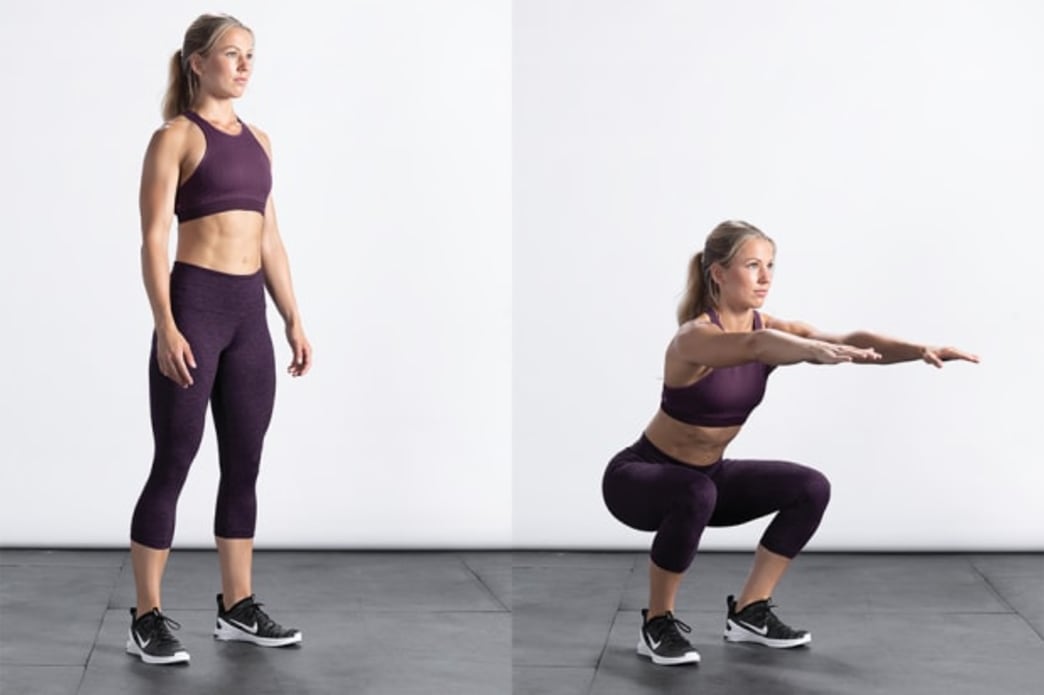 Oxygen Magazine
Oxygen MagazineAn air squat is as basic as it gets gym-side, but once you master this foundational move, all other squats — front, back, overhead or otherwise — become that much easier.
Air Squat
- Direct your gaze forward or at the ground a few feet in front of you. Looking up might feel like you’re getting extra drive, but you’re probably just arching your back.
- Initiate your squat by pushing your glutes and hips backward before you begin to bend your knees. This aligns and protects your joints and maximizes your lifting potential.
- On the descent, don’t let your toes curl up or allow your heels to lift. On the ascent, drive through your whole foot, not just your heels. If you’re having trouble feeling these pressure points, squat without shoes or socks and spread your toes to grip the ground.
- Your hips, knees and ankles should all flex and extend at the same time to ensure a proper squat pattern. For example, if your knees extend before your hips, you’ll moon the gym. Not a good look, and for sure not a correct squat.
- Your trunk and tibia should be parallel to one another at the bottom of the squat, so expect a slight forward lean. However, don’t let your shoulders round to maintain alignment and protect your spine.
- Don’t press your hips forward at the top. If you want an extra burn in your glutes, squeeze them isometrically without altering your hip position.
Squat Bucket List
- Air squat
- Front squat
- Back squat
- Pistol squat
- One-legged squat
- Split squat
- Smith-machine squat
- Sissy squat
- Plyometric squat
- Goblet squat
2. Lunge
Isn’t a lunge just a traveling squat? Yes, it is, and many coaches group it into the squat category. “A lunge is essentially any asymmetrical or single-leg stance with emphasis on the lower-body recruitment,” Rusin says. However, the lunge pattern requires more dynamic balance and control than a squat because it trains one leg at a time versus both simultaneously.
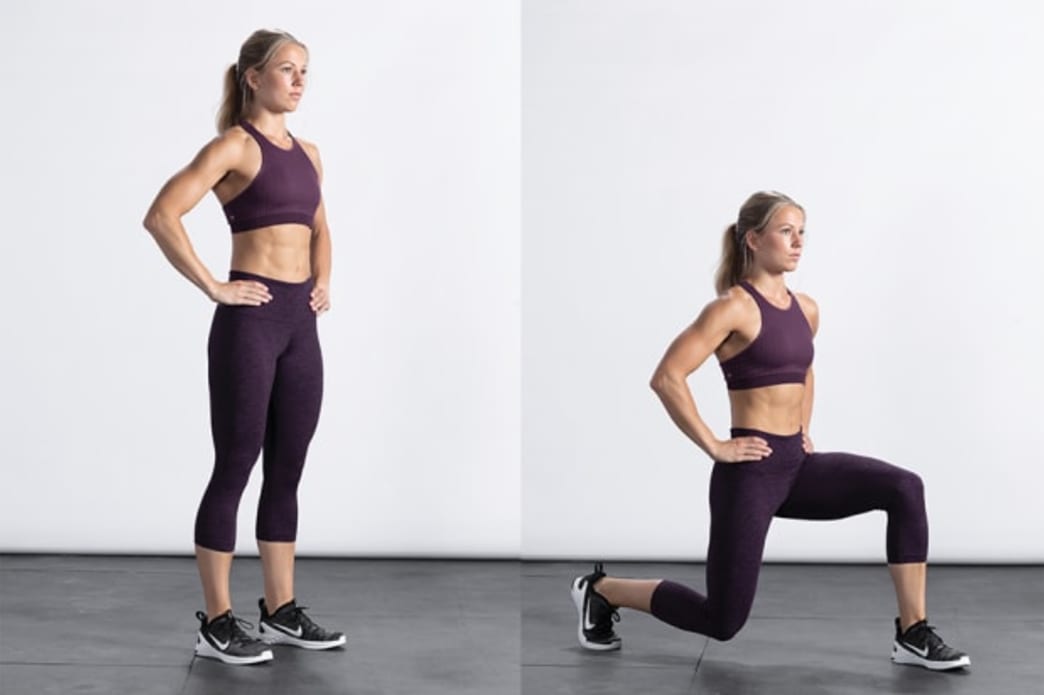 Oxygen Magazine
Oxygen MagazineTraining a forward lunge with just your bodyweight allows you to perfect your unilateral stability, balance and control without added resistance.
Forward Lunge
- Don’t take too big of a step forward. Maintain a 90-degree angle in your front hip and knee, and drop your back knee straight down, right underneath your hips, to avoid compromising your joints.
- Use your entire forward foot to push off and return to standing. Pressing through your toes will shift your weight forward into your knee and stress your patellar tendon, while only pushing through your heel narrows your base and can throw you off-balance.
- If you have tight hip flexors, you might hinge forward a bit at your hips. This is OK as long as you’re not rounding your lower back or using this forward lean to generate momentum to return to standing — a big temptation with step-ups and walking lunges. Eliminate the lean by slowing down the lowering phase to develop neuromuscular control.
- If you lack flexibility in your toes — especially the big toe — your rear foot may externally rotate in the down position, throwing off your alignment and balance. Loosen up your toes with some slow calf raises.
Lunge Bucket List
- Stationary lunge
- Forward lunge
- Reverse lunge
- Lateral lunge
- Walking lunge
- Rear-foot elevated lunge
- Lunge with rotation
- Switch lunge
- Curtsy lunge
- Around-the-clock lunge
3. Hinge
The hinge is one of the most underused functional movement patterns, perhaps because we’ve always been told to “lift with our knees.” But if you have a strong core, hinging is arguably a safer movement pattern for lifting a heavy object from the floor than squatting, and it certainly makes more sense to your body: You have far more muscle attached to the back of your legs than to the front, all perfectly positioned to raise your torso like a drawbridge.
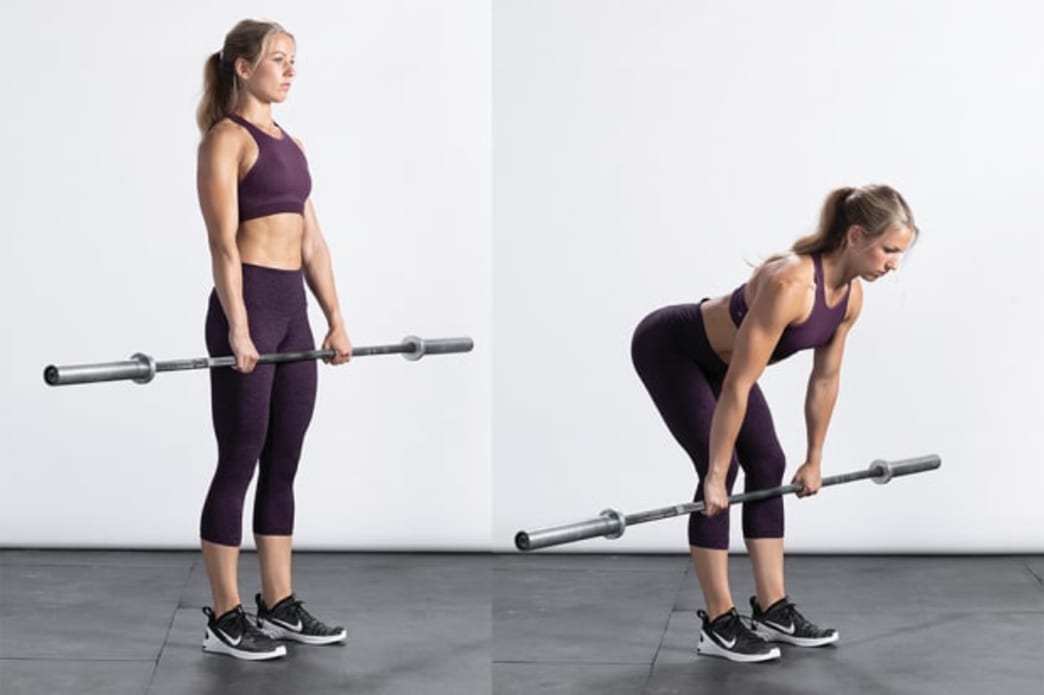 Oxygen Magazine
Oxygen MagazineEvery time you bend over to pick up the newspaper or the groceries or to pet your dog, you’re probably doing a deadlift.
Romanian Deadlift
- Maintain your neck and upper back alignment by gazing at the floor — not in front of you or in the mirror — in the starting position. Then “pack” your shoulders into your back by drawing your scapulae together and squeezing your armpits. Descend only as far as you can while maintaining a neutral spine. The moment your lower back starts rounding, you’ve gone too far and are putting your spine at risk.
- If you have very tight hamstrings, bend your knees a little to give them a break and increase your range of motion, but don’t make the move into a squat; the desired movement pattern is hinging — like a door that folds at your hips.
- Forceful hyperextension can over-stress your joints and really isn’t necessary to activate your posterior chain, so don’t overextend your knees at the top. They should be straight but not locked out.
- For extra glute activation, don’t push your hips out in front of your trunk, which causes your lower back to arch. Instead, tuck your pelvis under at the top and imagine pulling your pelvic bone toward your sternum (not launching your hoo-ha across the gym.)
Hinge Bucket List
- Romanian deadlift
- B-stance deadlift
- One-legged deadlift
- Banded kneeling hip thrust
- Bench hip thrust
- Kettlebell swing
- Kettlebell clean
- Glute-ham developer
- Reverse hyperextension
4. Push
The upper body really has two types of movement patterns — pushing something away from the trunk or pulling it closer. Push and pull are further divided into two more categories — vertical and horizontal. Because pushing and pulling are functional opposites, the key is to program them to create a balance in your up-and-down and front-to-back strength.
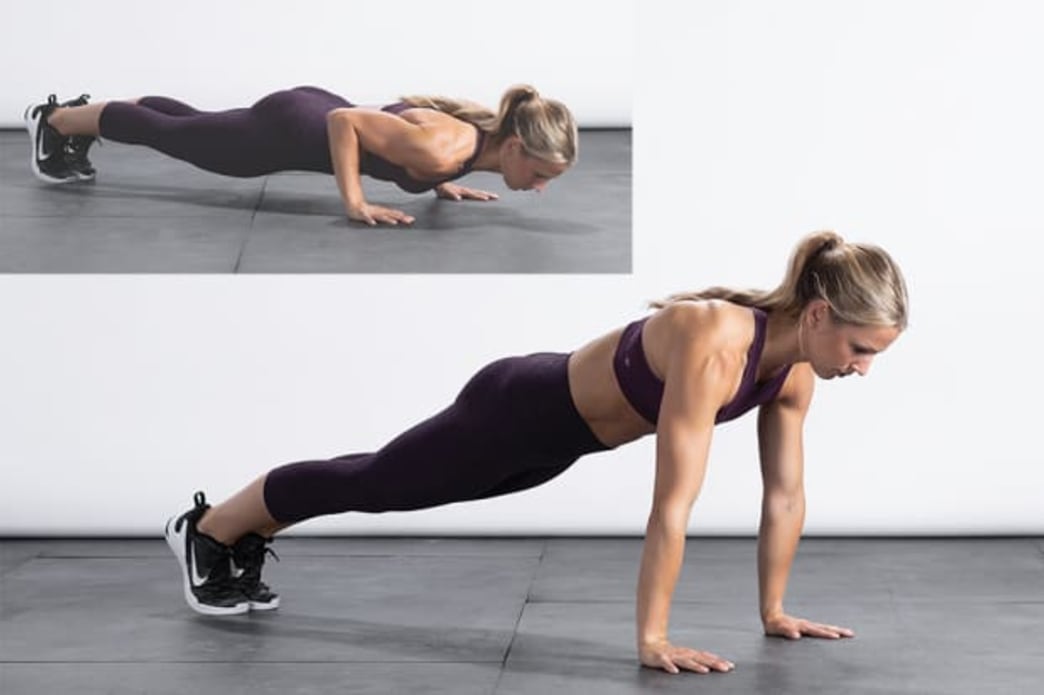 Oxygen Magazine
Oxygen MagazineHorizontal push exercise: Push-up
Horizontal Push: Push-Up
- Create stiffness in your core, hips and thighs by activating your abs, glutes and quads, which helps you maintain alignment from head to heels.
- Prevent your shoulders from shrugging by engaging your lats and squeezing the area under your armpits to rotate your elbow pits forward.
- Shoulder protraction and retraction are part of this pressing pattern, so at the top, push down into the floor to spread your shoulder blades apart without rounding your upper back (protraction). And on the way down, draw your shoulder blades together (retraction) but not so tight that your chest sticks out or your lower back arches.
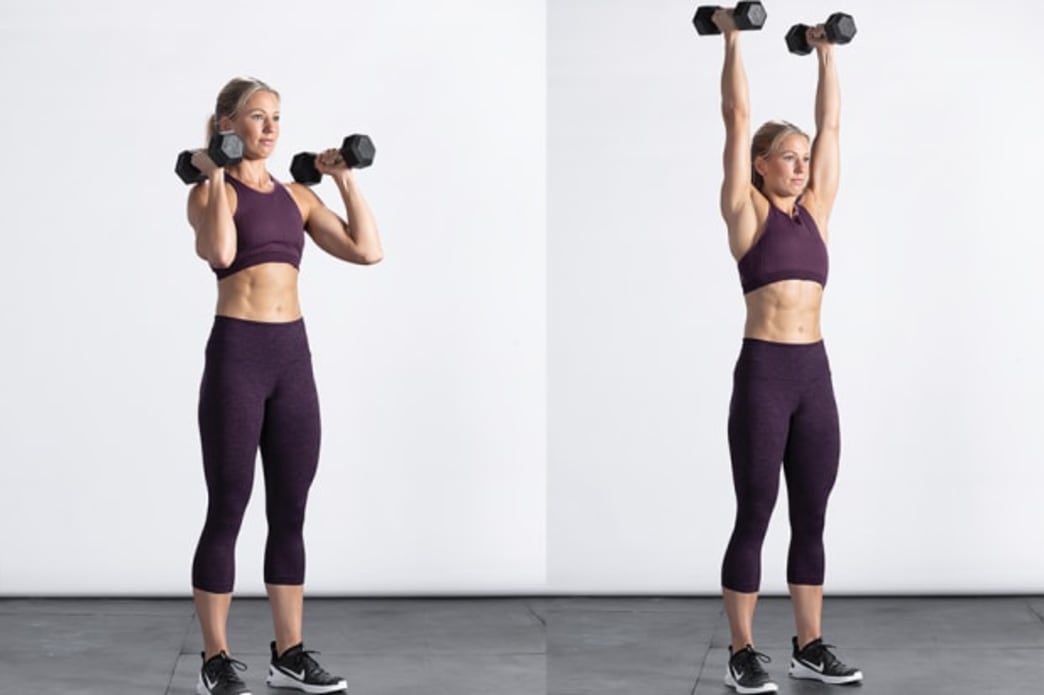 Oxygen Magazine
Oxygen MagazineVertical push exercise: Narrow overhead shoulder press
Vertical Push: Narrow Overhead Shoulder Press
- The narrow press with your palms inward is a lower-risk position than a traditional military press with your palms forward: The shoulder has more stability against rotation, making it easier to maintain stability with the weights overhead.
- Don’t allow your rib cage to flare outward and your lower back to arch as you extend your arms overhead. Instead, really focus on tightening your core to keep your ribs down.
- You’ve probably been told to keep your shoulders down and back with overhead movements. However, there has to be some upward rotation of the scapulae — otherwise, you’d get stuck halfway up. Simply be cognizant of the range of motion, and make sure that your shoulders are not shrugging to your earlobes — and you’re good.
Push Bucket List
HORIZONTAL
- Flat/incline/decline push-up
- Plank
- Flat/incline/decline bench press
- Straight punch
- Cable press (high and low)
VERTICAL
- Overhead shoulder press
- Handstand push-up
- Squat thrust
- Arnold press
- Windmill
- Wall ball
5. Pull
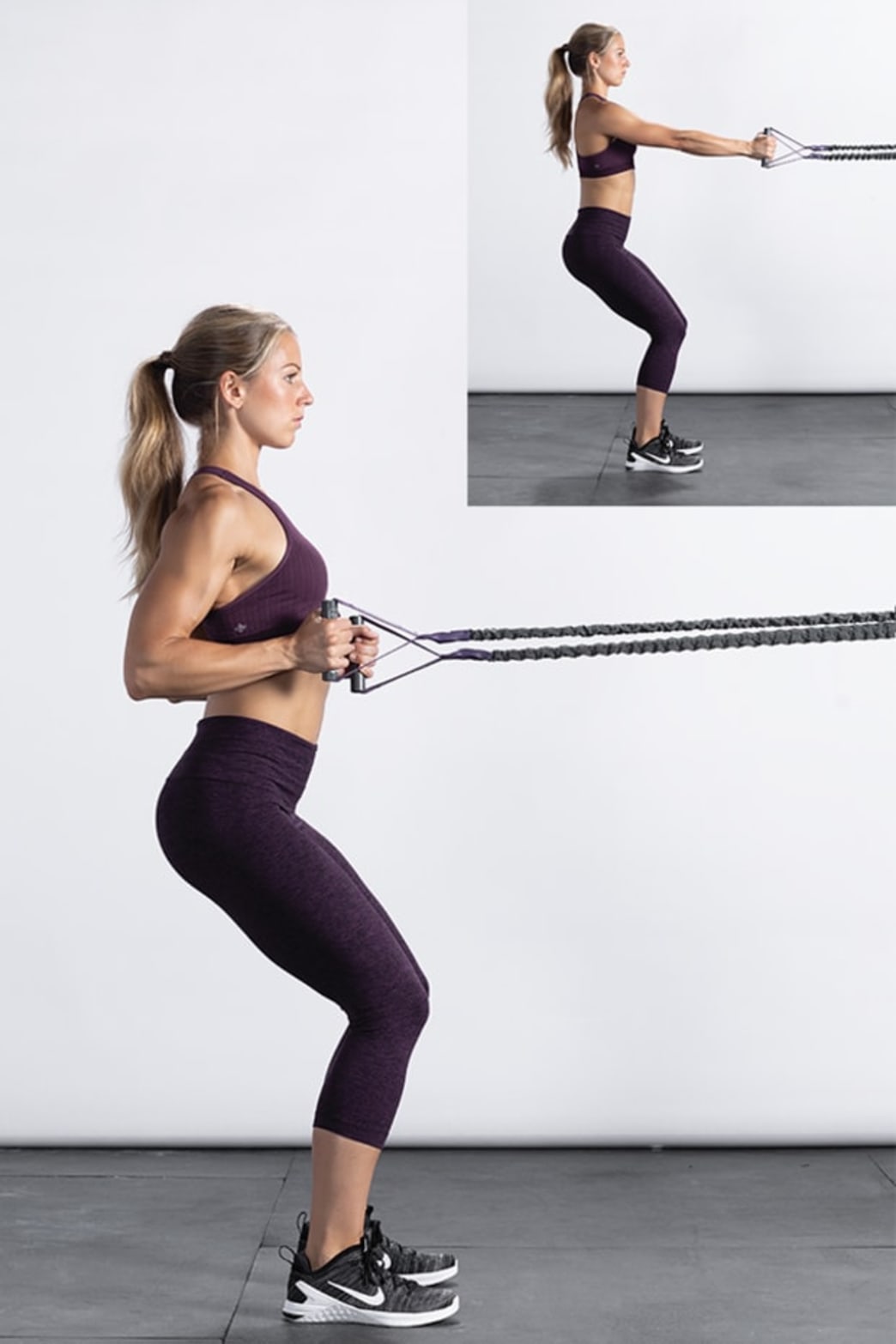 Oxygen Magazine
Oxygen MagazineRows can be done seated or standing with anything from a resistance band to a cable to a machine.
Horizontal Pull: Row
- Aim for full range of scapular motion for each rep — a little protraction at the start and full retraction at the top. As you pull your shoulder blades together, simultaneously contract your abs to keep your rib cage down and prevent your lower back from arching.
- Besides your shoulder blades and arms, no other parts of your body should be moving. Imagine your elbows and shoulders are on a conveyor belt and can only slide backward and forward to prevent excessive movement.
- You may feel like you’re pulling your shoulder blades backward, but in reality, you’re only jutting your chin forward. To prevent this, use a lighter weight and tuck your chin straight back.
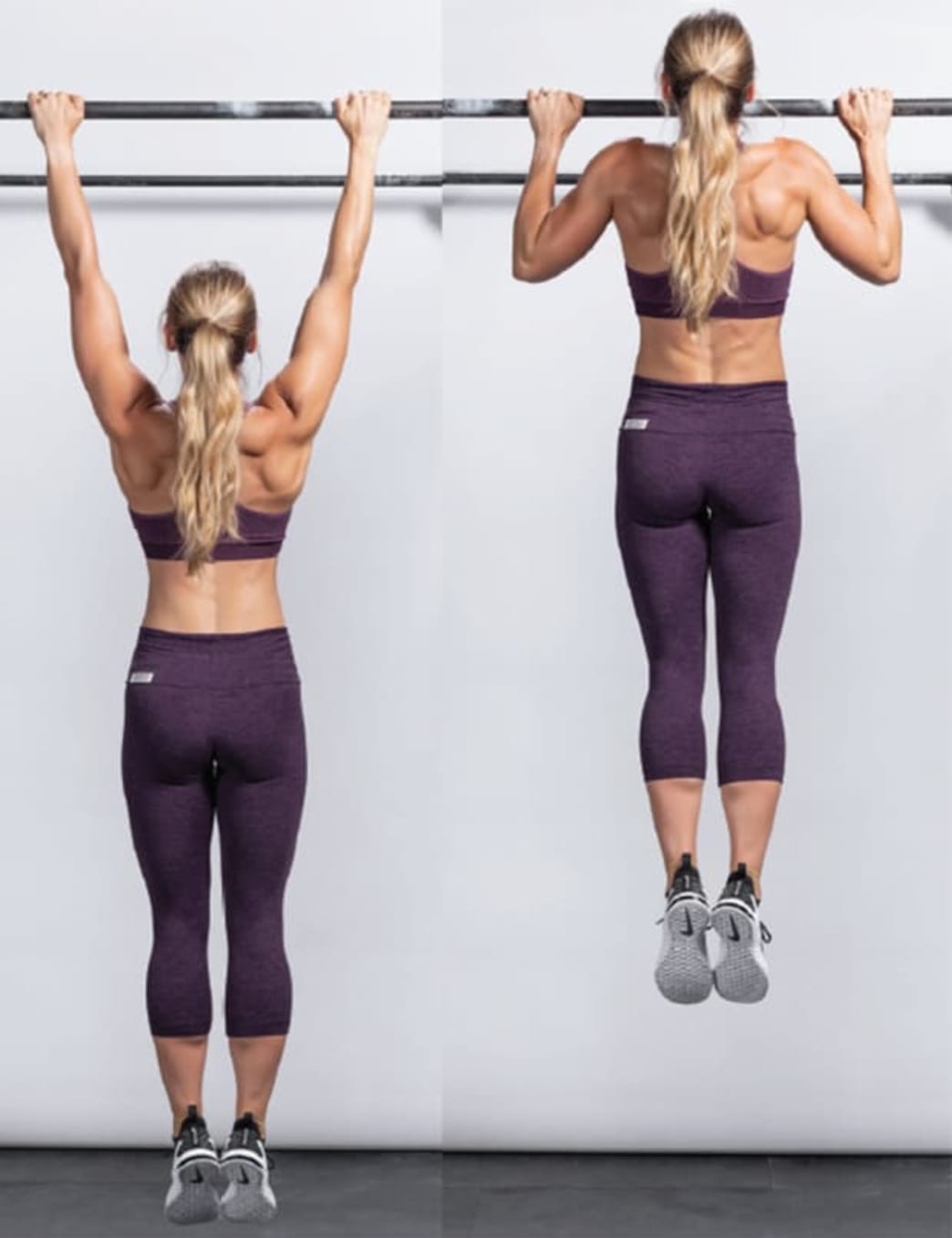 Oxygen Magazine
Oxygen MagazineVertical pull exercise: Pull-up
Vertical Pull: Pull-Up
- First, grip the bar right where your first knuckles meet your hand, then wrap your fingers and thumb around it. This presses the bar straight into your palm rather than pulling the spin on your palms upward, which can give you calluses or even tears.
- Don’t shortchange your reps: Let your shoulder blades slide upward toward your ears at the very bottom, then initiate the pull by drawing them together and packing them into your back before driving your elbows downward.
- There’s no harm in crossing your feet at the ankles, but it might tempt you to arch your lower back or swing your knees upward to create momentum. For a true measure of your pull-up prowess, keep your legs straight and together with your toes slightly in front of your torso.
Pull Bucket List
HORIZONTAL
- Seated row
- Single-arm row
- Bent-over row
- Reverse-grip row
- Lawn-mower row
- Renegade row
VERTICAL
- Pull-up/chin-up
- Lat pulldown
- One-arm pulldown
- One-arm wide lat pulldown
- Scapular push-up
- Active bar hang
6 Carry
Kettlebells, groceries, backpacks and pouting children — getting them from point A to point B without teleportation requires a solid carry, yet it’s an oft-ignored training tool. “With a carry, you won’t feel the burn in one area, but it’s the foundation of dynamic stability,” Zuniga says. More likely, you’ll feel a full-body stiffness as you traverse the ground with your arms and legs moving in opposition.
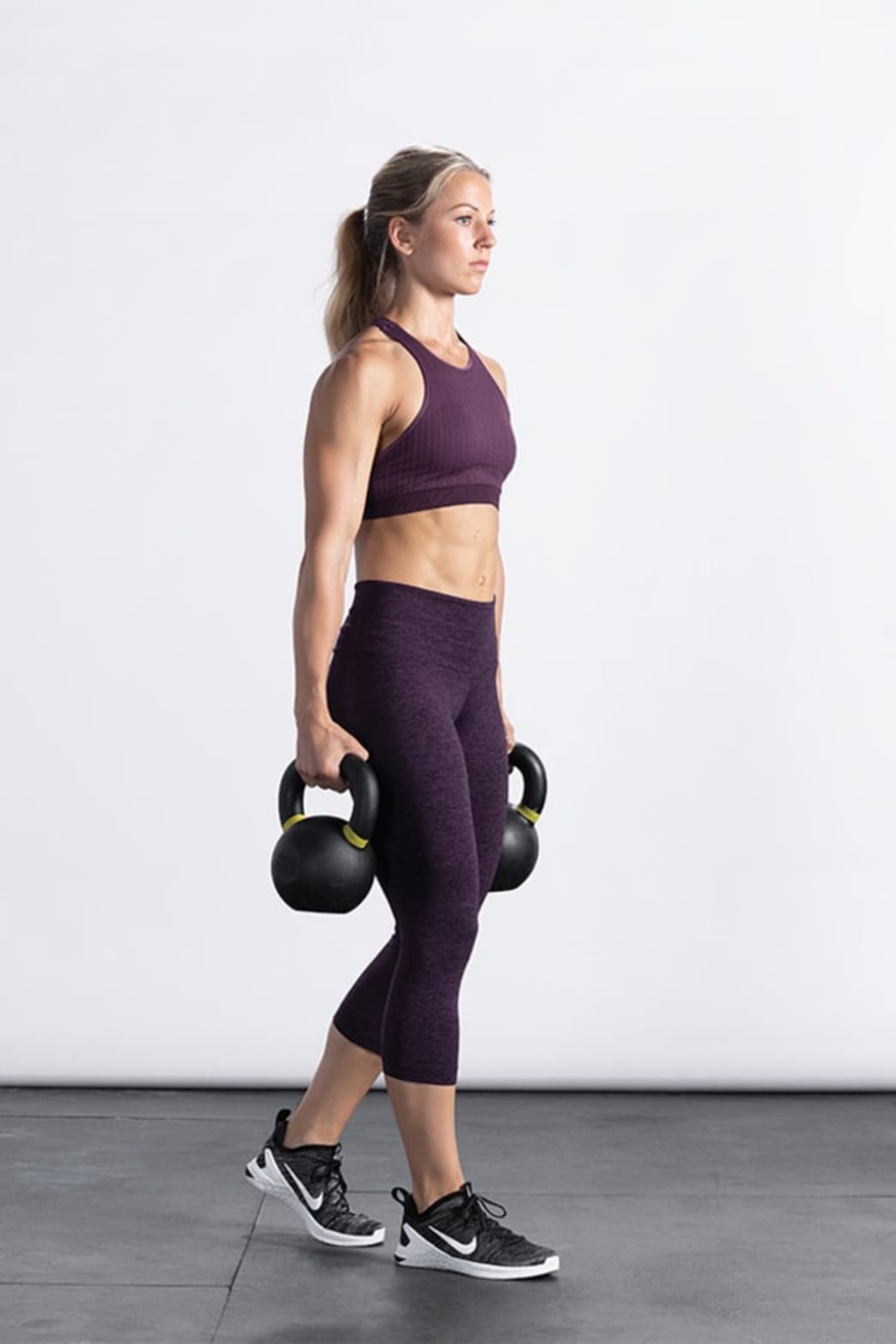 Oxygen Magazine
Oxygen MagazineBeing vertical is not essential when considering a carry. “Crawling with a weight on your back or using the Airdyne bike fits under the ‘carry’ umbrella,” Rusin says.
Farmer’s Walk
- Proper form is essential not only during the carry but also before and after: Use another foundational movement pattern — either a lunge or a deadlift — to pick up and set down the weights to protect your spine and joints.
- Take short, quick steps forward, planting each foot solidly, and don’t let your stance get too narrow. That decreases your base of support — and unless you’re training to walk a tightrope, you want to have as much support as possible when carrying heavy things!
- As you fatigue, you may be tempted to shrug, engaging your traps to help carry the load, but this can put undue tension on your neck and upper back. Instead, depress your shoulder blades, imagining sliding them down into your back pockets, to engage your bigger upper-back muscles.
Carry Bucket List
- Farmer’s walk
- Overhead walking lunge
- Waiter’s walk
- Suitcase carry
- Racked carry
- Unilateral sandbag carry
- Weighted bear crawl
- Sled drive/pull
Bonus: Rotate
Throwing, hitting, kicking, swimming and running (yes, running) all involve rotation, which is the best way to transfer power from your lower half through your core and out through your upper half. This pattern requires head-to-toe stability and teaches your body to work as a single unit rather than as separate halves. “Rotation is the glue that holds other movement patterns together — such as a squat plus a push or a hinge plus a pull — and helps create a full-body functional movement,” Rusin says.
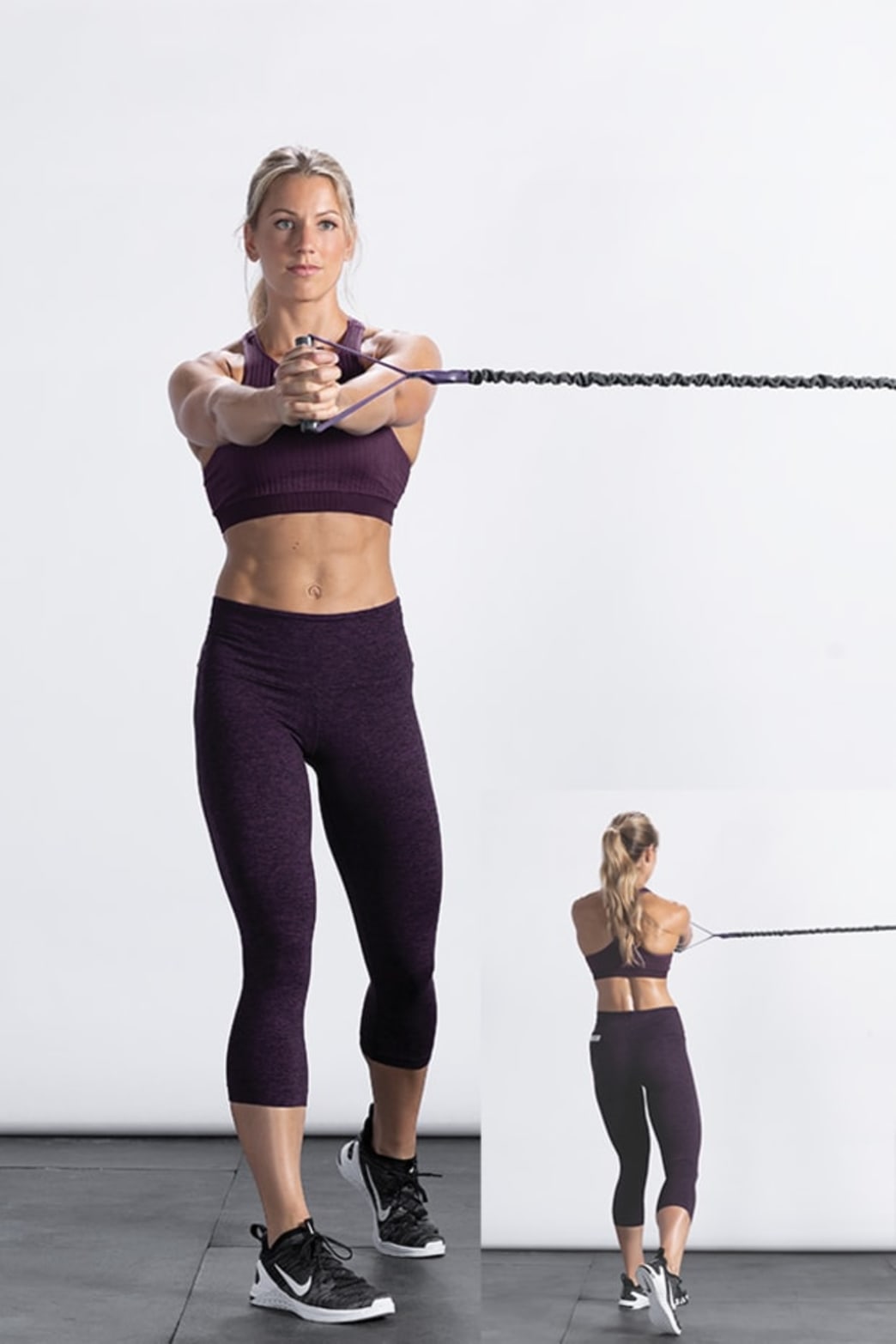 Oxygen Magazine
Oxygen MagazineAdd rotation to any of the other six movement patterns and immediately up the ante and feel the fire.
Band Rotation
- Don’t stand flat-footed. Come up onto the balls of your feet, and as you rotate, pivot from the start to the finish. This ensures that the move involves your whole body — including your hips and trunk — which is how rotation typically occurs in real life.
- Brace the core but allow some rotation of the spine, especially at the end ranges of motion. But note: You should feel a little stretch in your obliques but should not allow your trunk to flex forward or extend backward.
- The farther your arms are extended from your body, the greater the challenge to your core as it works to stabilize your shoulders and trunk. But make sure that your shoulders move as one unit with your torso, as if welded to your trunk. Some rotation may occur in the upper back (which is fine), but avoid pulling and/or pressing the band with your chest and arms.
Rotation Bucket List
- Cable/band rotation
- Woodchopper
- Oblique medicine-ball toss
- Plank to side plank
- Hook punch
- Throwing (balls, rocks, etc.)
- Swinging (bat, golf club, etc.)
Pop Quiz
Are the lat pulldown and the bench press functional opposites?
ANSWER: No. A lat pulldown is a vertical pull, and the bench press is a horizontal push. The opposite of a vertical pull would be a vertical press like a dumbbell overhead press, whereas the horizontal push is best opposed by a horizontal pull, like a row.
Written by NASM Master Trainer for Oxygen Magazine and legally licensed through the Matcha publisher network. Please direct all licensing questions to legal@getmatcha.com.
Featured image provided by Oxygen Magazine
Nutrition for an Active Lifestyle with MariGold
Staying active is very important to our overall health, and so is nutrition!
Exercising is simple, but sometimes not easy… and you want to make sure you’re fueling your body with the right ingredients to make sure it functions at its best.
At MariGold, we create products designed to treat your body well in all stages of life and levels of activity.
Whether you’re a pro athlete, body builder, a busy working professional, or stay at home parent, we’ve got you covered.
Our Grass-Fed Whey Isolate Protein Powder is perfect for a morning or afternoon shake, or even adding to your favorite smoothie or meals for a nutrient-rich protein boost. With 21+ grams of protein and 5-6 BCAAs, our premium quality protein can help you build and maintain muscle, as well as help your muscles recover faster after a hard workout.
We also include non-GMO sunflower lecithin that is rich in phosphatidylcholine to help promote a healthy brain and sharpen memory. Our flavored protein powders also contain L-Glutamine for increased muscle performance and to help improve gut health and boost your immune system.
We also have Grass-Fed Protein Bars that use the same high quality protein and come in a variety of delicious flavors like Cookie Dough and Salty Caramel. Our Protein Bars, as well as our Fat Bombs and Snack Nuts are all perfect for quick and easy, on-the-go snacks (and even desserts!). Our snacks will help keep your blood sugar levels in check and keep you feeling full and satisfied with healthy, REAL FOOD ingredients.
Our Grass-Fed Collagen Peptides are also a great option for getting a protein boost with added skin-rejuvenating and bone-strengthening benefits. As we age, it’s important to keep our bodies strong…and collagen supplementation can help restore ease of movement by replenishing joints and connective tissue, including cartilage and tendons. It can even improve gut & immune function.
If you’re a coffee-lover, you’ll also enjoy our High Protein Coffee collection! We combine antioxidant and flavonoid-rich organic Arabica coffee with your choice of Whey Isolate or Collagen Peptides protein for a clean energy boost to start your day off the right way.
Treat your body well with MariGold!


